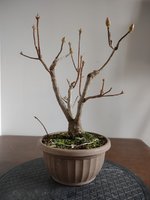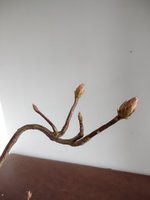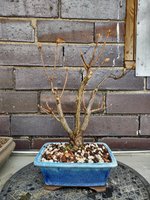Looking at the pictures on your other thread, I am virtually certain of two things: your azalea is deciduous, and it is not Girard’s Scarlet. The Girard azaleas, of which there are about 25 cultivars, are American hybrids that contain genetic material from the R. Kaempferi azaleas, also known as torch azaleas, native to Japan.
To be technically precise, no azalea is truly “evergreen” in the same sense as a conifer. The ones so labeled are more correctly called ‘semi-deciduous’, in that in winter they will drop foliage put on during spring of the previous year. They appear evergreen because they retain the foliage produced during the current year’s growing season. Depending on autumn and winter weather, the Girards will change color on some leaves, and then usually drop some of them. I’ve never had one go completely bare unless I killed it.
This is a picture of a Girard’s Hotshot, taken in my greenhouse just moments ago:
View attachment 420732










